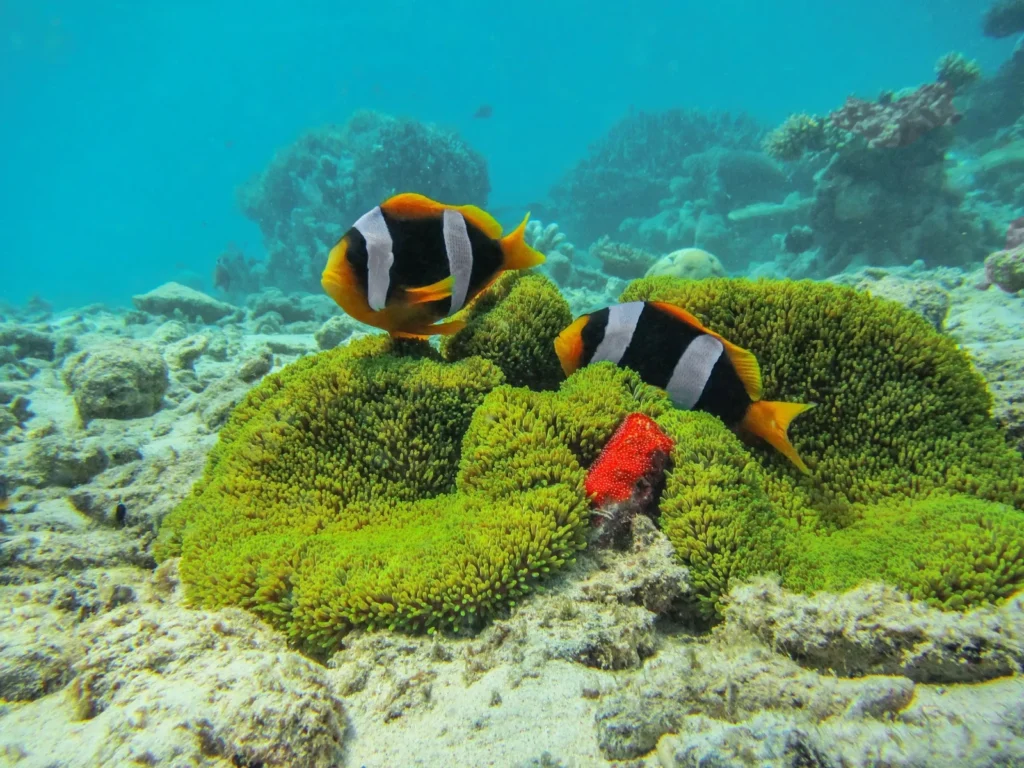Among the numerous representatives of clownfish, a special place is occupied by broadband clown (Amphiprion latifasciatus). It is known for its large size, massive body structure and wide white stripes, which gave it its name.
This view – rare and endemic for the western Indian Ocean, namely Madagascar and neighboring islands. Due to its uniqueness, the broadband clown enjoys popular with aquarists, however, its natural abundance is limited.
In this article, we will take a closer look at:
✔ Classification and origin
✔ Appearance and color scheme
✔ Habitat and symbiosis with anemones
✔ Lifestyle, social structure and behavior
✔ Diet and nutrition
✔ Reproduction and characteristics of hermaphroditism
✔ Conditions of keeping in the aquarium
✔ Threats and protected status

Scientific classification
✔ The Kingdom: Animals (Animalia)
✔ Type: Chordal (Chordata)
✔ Class: Lucheperi pisces (Actinopterygii)
✔ Row: Perch-like (Perciformes)
✔ Family: Pomacentrovye (Pomacentridae)
✔ Gender: Amphiprions (Amphiprion)
✔ View: Amphiprion latifasciatus
🔍 The name "latifasciatus" means "broad-banded" and reflects the characteristic white stripes on the fish's body.
Appearance and color scheme
🎨 Main Features:
✔ The body is dark brown or black
✔ Two wide white stripes:
• One goes through the head behind the eyes
• The second is located in the middle of the body
✔ The caudal fin is usually white or yellowish
✔ Body length reaches 14-15 cmwhich makes it one of the the largest ones representatives of clownfish
🔥 This species has an impressive appearance due to its contrasting coloration and large size.
Habitat and habitat
🌍 Geographical distribution
The broadband clown lives in a restricted area:
✔ Madagascar
✔ Reunion Islands and Mauritius
🏝 Typical biotopes:
✔ Lagoons and coral reefs at depths of up to 20 meters
✔ Lives in sea anemonesthat provide it with protection
🌊 Symbiotic anemones:
Amphiprion latifasciatus co-exists with:
✔ Heteractis magnifica (giant anemone)
✔ Stichodactyla mertensii (Mertens ' anemone)
🐠 The role of the anemone:
✔ Protection from predators
✔ A safe place to spawn
✔ Getting leftover food from clownfish
Lifestyle and behavior
🔹 Territoriality
✔ Very attached to your anemone
✔ Protects your territory from other fish
🔹 Social structure
✔ Live in groups with a clear hierarchy
✔ Dominant female - the biggest fish in the group
✔ If the female dies, the largest male changes sex she becomes a new female
🔹 Aggressiveness
✔ Moderately aggressive, especially during the spawning season
✔ Drives even larger fish away from the anemone
Diet and nutrition
🍽 In the natural environment:
✔ Small crustaceans (copepods, mysids)
✔ Planktonic organisms
✔ Seaweed
🍽 In the aquarium:
✔ Live and frozen food (Artemia, bloodworm, krill)
✔ High quality pellets and flakes
✔ Herbal Supplements
Reproduction and sexual dimorphism
🔹 Hermaphroditism
✔ Amphiprion latifasciatus there is a consistent hermaphrodite
✔ There is only one female in the group, the rest are males
✔ After the death of a female, the largest male turns into a female
🔹 Spawning process
✔ Female lays eggs up to 600 eggs at the base of the anemone
✔ The male guards the clutch and ventilates the eggs
✔ Larvae hatch in 6-10 days
Keeping in the aquarium
🟡 Basic requirements:
✔ Aquarium capacity: from 150-200 liters
✔ Water temperature: 24–28°C
✔ Salinity: 1.020–1.025
✔ Filtering: powerful, with good circulation
🟡 Compatibility:
✔ Peaceful reef fish – gubani, surgeons
✔ Best to keep with anemone
🟡 Incompatibility:
Great large aggressive fish (triggerfish, moray eels)
Other types of clownfish in a small aquarium
Threats and protected status
❗ Main threats:
✔ Destruction of coral reefs
✔ Catch for aquarium trade
🌱 Is it going to disappear?
✔ Amphiprion latifasciatus it doesn't have an official threat status, but its population is limited
✔ Protected within marine reserves
Conclusion
Broadband Clown – a unique representative of clownfish, which is highlighted large size, wide white stripes and a rare habitat.
💙 Due to its beauty and interesting behavior, this species is a true gem of coral reefs and aquarium hobby. 🌊🐠